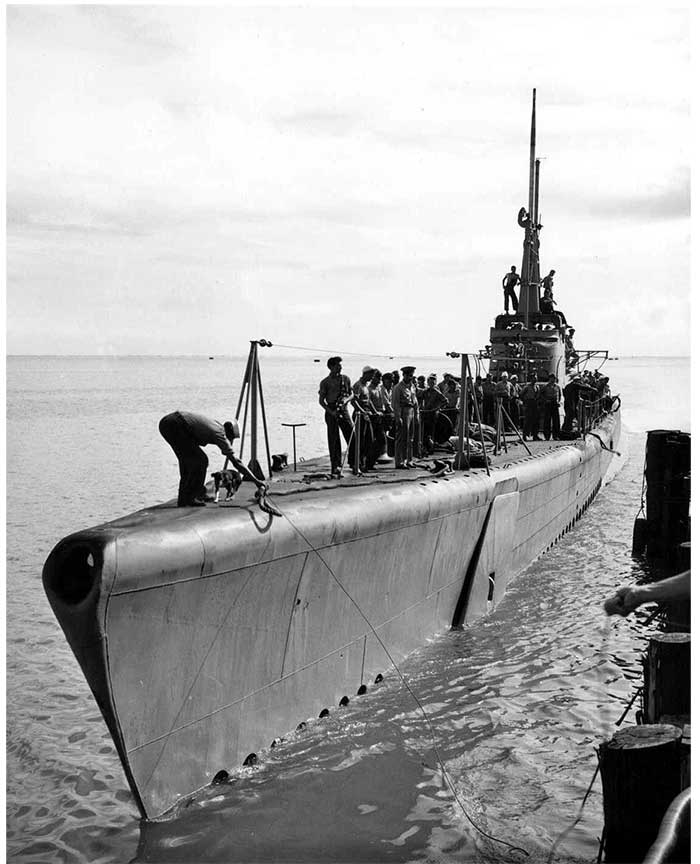Gabilan SS-252

Gabilan
An eagle-ray fish of the Gulf of California.
• (SS-252: dp. 1,526; 1. 311'9", b. 27'3"; dr. 15'3"; s.20 k.; cpl. 60; a. 1 5", 2 .50 cal. mg., 2 .30 cal. mg., 10 21" tt.; cl. Gato)
Gabilan (SS-252) was launched 19 September 1943 by the Electric Boat Co., Groton, Conn.; sponsored by Mrs. Jules James, wife of Rear Admiral James, and commissioned 28 December 1943, Comdr. K. R. Wheland in command.
After shakedown out of New London, Gabilan sailed for brief antisubmarine training at Key West before transiting the Panama Canal for the Hawaiian Islands. She arrived Pearl Harbor 23 March 1944 and spent her first war patrol (21 April-6 June) scouting the Marianas gathering information for the United States invasion of those islands. Her second war patrol (29 June-18 August) took her to the south coast of Honshu, Japan, where, on the night of 17 July, she made a daring radar chase through bright moonlight and phosphorescent water. Skirting dangerous reefs and shoals, she pressed home an attack that sank a 492-ton minesweeper. Her third war patrol (26 September-12 November) took her south of the Japanese Empire in company with Besugo (SS-321) and Ronquill ( SS-396) to detect the departure from Bungo Suido of any major enemy fleet units that might interfere with the campaign to liberate the Philippine Islands. The latter period of the patrol was independent search of approaches of Kii Suido where, in a dawn periscope attack on 31 October, she destroyed auxiliary ship Kaigo No. 6 with a single torpedo.
Gabilan terminated her third war patrol at Saipan on 12 November 1944, and proceeded to Brisbane, Australia, for refit. Her fourth war patrol was in the South China Sea (29 December 1944-15 February 1945). She Joined Perch (SS 313) and Barbel (SS-316) in a coordinated patrol off the southern entrance to Palawan Passage and the western approach to Balabac Strait, where Japanese battleships Ise and Hyuga were expected to appear en route to threaten American invasion forces in the Philippines. There were many quick dives to avoid aircraft; floating mines were sunk by rifle fire from the submarine, but there was no sign of their quarry. Passing back through the Java Sea en route to Fremantle, the submarine had a nerve wracking morning as numerous aircraft dropped depth charge bombs in the near vicinity, culminated by the appearance of a Japanese minelayer that made two deliberate attacks in shallow water, dropping 20 depth charges. Thoroughly shaken, but suffering only superficial damage, Gabilan evaded her antagonist in a providential heavy rain squall. Her only other diversion en route to Fremantle was an encounter with British submarine EMS Spiteful, an approach target in morning twilight; but, fortunately, there was sufficient illumination to enable Gabilan to identify Spiteful at the last moment before firing.
Gabilan conducted the greater part of her fifth war patrol (20 March-28 May) as a unit of a "wolf pack" that included Charr (SS-328) and Besugo (SS-321). Patrolling below the Celebes, the pack began an epic four day chase on 4 April with a mourning contact on cruiser Isuza and her four escorts. One of the escorts fell prey to Besugo, and the elusive cruiser was spotted as she entered Bima Bay on the night of 6 April. Word was flashed to Gabilan, already executing a daring surface attack that left the cruiser listing and down by the bow. With the enemy formation confused by Gabilan's attack, Charr completed the kill with a six torpedo salvo on the morning of 7 April. The demise of Isuza, last of the Japanese light cruisers to fall victim to a submarine torpedo, was witnessed by British submarine Spark.
Gabilan outwitted three efforts to sink a small freighter the morning of 14 April 1946, then scored hits in two cargo ships of another convoy. After a short stay off the coast of Hainan where she destroyed drifting mines, she returned to Pearl Harbor 28 May for refit.
Gabilan's sixth and last war patrol (20 June-17 August 1945) was on lifeguard station for American fliers off Tokyo Bay. She first rescued six men, the crews of two torpedo bombers; then raced well inside Tokyo Bay, in easy range of shore batteries, to rescue another three-man crew. Six Navy "Hellcat" fighter planes gave her cover for the mission. On the way out, she paused to destroy a drifting mine with gunfire. Altogether, on this patrol Gabilan rescued 17 aviators.
En route to Pearl Harbor, Gabilan received news of the Japanese surrender. Steaming by way of San Francisco and the Canal Zone, Gabilan arrived New London, Conn., where she decommissioned 23 February 1946 and joined the Atlantic Reserve Fleet. She was sold for scrapping 15 December 1959.
Gabilan received four battle stars for World War II service. Her second, third fifth, and sixth war patrols were designated "successful"
A county in Florida.
